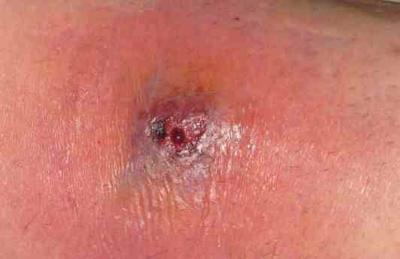- CLICK FOR INFO ON SPIDER BITES AND THE SYMPTOMS
- CLICK HERE TO READ MORE DETAILS ON THIS STORY
- CLICK HERE TO WATCH VIDEO OF MAN DRAINING SPIDER BITE CYST
KHQ.COM - Spiders get a pretty bad rap in the world of first aid. Plenty of red, raised welts have been identified, either correctly or incorrectly, as spider bites. Despite the belief by many victims that spiders are responsible for their pain, spider bites are often harmless. Indeed, most true spider bites go unnoticed and untreated.
Did you go to the doctor and get diagnosed with a spider bite -- or misdiagnosed? Did you have a particularly difficult experience trying to heal after a spider bite? Share your story below and learn about other readers' spider bites.
Almost all spiders are venomous. That's how they hunt. Most spiders are too small, or their venom too weak, to be dangerous to humans.
In the United States, black widow spiders are often considered the most venomous. Other countries have a widow spider called the red-back spider. It's probably a good idea to consider any shiny, black spider with a red mark to be in the widow family. Another type of widow spider, the brown widow, generally has a weaker toxin and can be found worldwide.
Brown recluse spiders have garnered plenty of attention in the last ten years or so. Despite the large wounds often associated with brown recluse, they are much less likely to cause significant injury than black widows. Brown recluse are also misdiagnosed quite a bit, with abcesses attributed to them that they didn't cause.
Brown Recluse spiders are only found in the Southeast United States. There are several other species of recluse spider, but none are as dangerous as the brown recluse. Brown recluse spiders have a violin-shaped mark on the back of their midsections.
Spider Bite Symptoms
Determining whether a victim has been bitten by a spider may be impossible. Studies of brown recluse spiders have shown that victims seek treatment more than three days after their bites, making it nearly impossible to identify the culprit. Black widow bites are often identified only by symptoms of its venom, without any visible local bite.
For an idea how spider bites may look, check out the spider bite picture gallery.
Local reactions to bites from all manner of toxic bugs look the same:
- redness
- swelling
- itching
- pain
victims should be concerned when a local reaction continues to get worse for more than 24 hours. Look for redness spreading away from the bite, drainage from the bite, increase in pain, numbness/tingling, or a discoloration around the bite that looks like a halo or bullseye.
Victims should also call a doctor if they are not up to date on their tetanus vaccinations.
Anaphylaxis is always the biggest concern with any type of bug bite. If the victim exhibits any signs of allergic reaction or anaphylaxis shortly after a bug bite, call 911.
- hives
- shortness of breath
- wheezing
- weakness
Victims should seek medical treatment if symptoms appear in parts of the body away from the location of the bite. Black widow spiders have a toxin that affects muscle contraction and nerve function. Severe brown recluse spider bites can also cause some symptoms over the entire body (systemic reaction). Look for:
- sweating
- chills
- headache
- body aches
- stomach cramps
- leg cramps
- rapid pulse
- exhaustion
In cases where the victim is feeling extremely tired or weak, call 911.
First Aid for Spider Bites
Perform first aid for common bug bites if a wound is found. There is no specific first aid for spider bites. Systemic reactions to black widow or brown recluse bites have to be treated by medical staff, often in the emergency department.
Victims should call a doctor or go to the emergency department if symptoms persist more than 24 hours or get worse.
There are many home remedies offered for the treatment of insect and spider bites. Most of these have not been shown to provide any real benefit. Meat tenderizer (papain) has even been implicated in allergies and asthma reactions to its protein. Suction syringes designed to extract toxins do not work and are a complete waste of money.



















